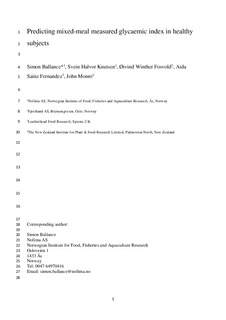Predicting mixed-meal measured glycaemic index in healthy subjects
Journal article, Peer reviewed
Submitted version
Permanent lenke
http://hdl.handle.net/11250/2565724Utgivelsesdato
2018Metadata
Vis full innførselSamlinger
- Artikler / Articles [1419]
- Publikasjoner fra CRIStin [2481]
Originalversjon
10.1007/s00394-018-1813-zSammendrag
Purpose To determine the influence of meal composition on the glycaemic impact of different carbohydrate staples, and the accuracy of “adjusted calculated meal GI” compared with “measured mixed-meal GI”. Methods In a non-blind randomized crossover trial fasted healthy subjects consumed four dinner-type mixed meals of realistic serving size comprising a carbohydrate staple of either mashed potato, pasta, rice or a glucose drink, combined with fixed portions of boiled carrots, poached salmon and herb sauce. Blood samples collected between 0 and 180 min were analysed for glucose and insulin concentrations. Adjusted calculated meal GI values were determined against a 50 g reference glucose drink, and compared to corresponding measured mixed-meal GIs, supplemented with data from four previous mixed-meal postprandial glycaemic response studies. Results The common carbohydrate staples, and the glucose drink, ingested as part of the salmon mixed meal induced a significantly lower post-prandial relative glycaemic response (RGR) and concurrent higher relative insulin response than the same amount of staple eaten alone. Adjusted calculated mixed-meal GI closely predicted measured mixed-meal GI in healthy subjects for 15 out of 17 mixed meals examined, showing the need to account for effects of fat and protein when predicting measured mixed-meal GI. Further, we showed the validity of using customarily consumed food amounts in mixed-meal postprandial RGR study design. Conclusions Adjusted calculated mixed-meal GI appears a useful model to predict measured mixed-meal GI in healthy subjects and with further development and validation could aid nutrition research and rational design of healthy meals for personalized nutrition and particular consumer groups. Predicting mixed-meal measured glycaemic index in healthy subjects
